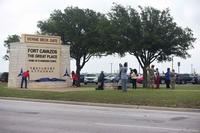Army Chief of Staff Gen. Ray Odierno is drawing fire from Army National Guard advocates over comments he made a week ago that seemed to dismiss the country's citizen-soldier force as second stringers compared to active duty soldiers.
Retired Army Maj. Gen. Gus Hargett, president of the National Guard Association of the U.S., accused Odierno in a statement Monday of disparaging Guard troops by telling reporters in a press conference that the Guard's "capabilities are not interchangeable" with the active-duty Army's.
It may not have sounded like a knock, "but his message was loud and clear to 350,000 members of the Army Guard force nationwide," Hargett said. "I know because I have heard from more than a few. And many asked me to respond."
Odierno's remarks about the National Guard before the National Press Club in Washington on Jan. 7 were framed in the context of why the active-duty component is more expensive to maintain than the Guard.
Odierno said the Army and its reserve components -- the National Guard and the Army Reserve -- complement each other but have different capabilities.
"There is a reason the active component is more expensive. It brings you a higher level of readiness because they're full time," he said. "They're trained and ready to do things at a higher level because they spend every day focused on that."
While Odierno acknowledged that the Guard "has done an incredible job" over the past dozen years of war, he pointed out a typical Guard unit train 39 days a years.
"So they're not interchangeable. So to say the National Guard is cheaper to replace the active component, it's not true," Odierno said.
National Guard Bureau Chief Gen. Frank Grass, who appeared before the National Press Club two days later, did not criticize Odierno for his remarks but did suggest the Army chief of staff was not aware of the changing demands of Guard training.
"I've been trying to find the person who trains" for 39 days a year, he said. Grass said it has been many years since a typical Guard soldier could put in 39 days a year. Many are at the armory once or twice a week, and a great many also attend professional military training courses for months at a time, he said.
Grass is the second Guard Bureau boss to have a seat on the Joint Chiefs of Staff, which has enabled him to make his own case for the Guard's future to Secretary of Defense Chuck Hagel.
Currently, there is a debate over just how much the active duty and reserve components should draw down with the U.S. withdrawing from Afghanistan in 2014. The reserve component is made up by Army Reserves and Army Guard.
During the wars in Afghanistan and Iraq, the active duty Army was grown to make up 51 percent of the total Army force.
Odierno said the Army should constitute 46 percent of the total. Depending on what the Army is forced through budget cuts to draw down to, it may ask for further reductions in the Guard to ensure that ratio remains in place.
National Guard advocates believe the Guard's total force should not be imposed by the active duty Army, especially if it can find the funding to maintain higher end strength. The active duty Army will reduce its end strength to 420,000 by 2019.
National Guard Association spokesman John Goheen said the Guard believes it can continue to maintain a strength of about 345,000 -- a cut of just 5,000 soldiers from its current number. But under the Army's plan, it would go down to 315,000, a loss of 35,000 people.
Goheen said the Army has yet to share with the Guard its analysis to show why the 54/46 ratio that Odierno is advocating is best suited to meet national defense requirements.
Hargett, in his statement on Monday, said there should be a "vigorous debate" about the way ahead for the Army and the reserve components.
"Everything should be on the table, all the options, all the costs, all the analysis," he said.


























